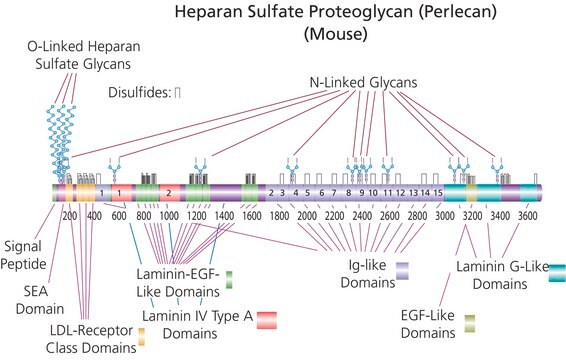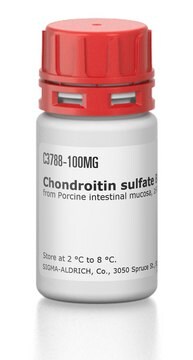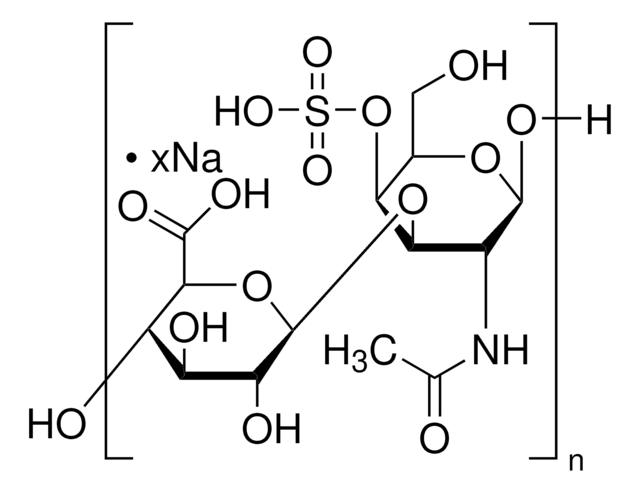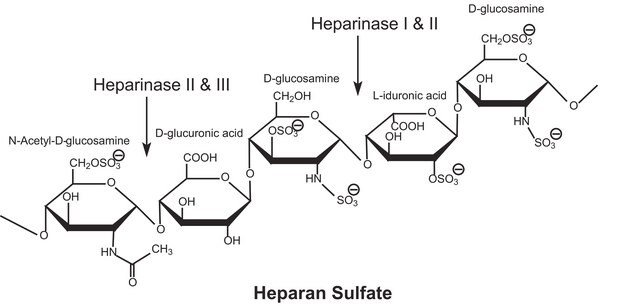H7640
Heparan sulfate sodium salt from bovine kidney
powder, extracellular matrix component
Synonym(s):
Heparitin sulfate sodium salt
Sign Into View Organizational & Contract Pricing
All Photos(3)
About This Item
Recommended Products
Looking for similar products? Visit Product Comparison Guide
Application
Heparan sulfate sodium salt from bovine kidney has been used:
- to investigate its effect on proliferation of B cells
- to monitor its role on eye development in E5 embryonic cells
- to study its binding with exosome fibronectin in human trabecular meshwork cells using dot blot
Biochem/physiol Actions
Heparan sulphate (HS), a ubiquitous glycosaminoglycan, is a polymer of D-glucuronic acid or L-iduronic acid and D-glucosamine (GlcA) sugars. It is synthesized in the cis-Golgi as heparan. In Golgi, final heparan sulphate is synthesized in by the action of enzymes N- and O-HS-sulphotransferases and HS epimerase. The mature HS has 50 to 200 disaccharide units. It is part of the extracellular matrix (ECM) and plays a key role in the oncogenic pathway. Deregulation of heparin sulfate metabolism is implicated in cancer progression. HS is associated with the onset of infectious diseases and inflammatory conditions. HS interaction with Aβ fibrils contributes to the pathophysiology of Alzheimer′s disease.Heparan sulphate is a constituent of membrane-associated proteoglycans suggested to contribute to cell-cell adhesion.
Constituent of membrane-associated proteoglycans suggested to contribute to cell-cell adhesion
Storage Class Code
11 - Combustible Solids
WGK
WGK 3
Flash Point(F)
Not applicable
Flash Point(C)
Not applicable
Personal Protective Equipment
dust mask type N95 (US), Eyeshields, Gloves
Certificates of Analysis (COA)
Search for Certificates of Analysis (COA) by entering the products Lot/Batch Number. Lot and Batch Numbers can be found on a product’s label following the words ‘Lot’ or ‘Batch’.
Already Own This Product?
Find documentation for the products that you have recently purchased in the Document Library.
Customers Also Viewed
Y Tanaka et al.
The Journal of experimental medicine, 184(5), 1987-1997 (1996-11-01)
Leukocyte migration from circulation into tissue depends on leukocyte integrin-mediated adhesion to endothelium, but integrins cannot function until activated. However, it remains to be understood how tumor cells adhere to endothelium and infiltrate into underlying tissue. We studied mechanisms of
K Fuxe et al.
Brain research, 746(1-2), 25-33 (1997-01-23)
In the present paper immunocytochemical analysis at the fluorescence microscopical level has been performed of neural cell adhesion. molecule (NCAM) immunoreactivity in the adult rat tel- and diencephalon in order to further substantiate the highly selective neuronal localization of NCAM
Molecular diversity of heparan sulfate
Esko JD and Lindahl Ulf
The Journal of Clinical Investigation, 108(2), 169-173 (2001)
Mechanism of fibronectin binding to human trabecular meshwork exosomes and its modulation by dexamethasone
Dismuke WM, et al.
Testing, 11(10), e0165326-e0165326 (2016)
Towards understanding the roles of heparan sulfate proteoglycans in Alzheimer?s disease
Zhang GL, et al.
BioMed Research International, 2014(6), 555-571 (2014)
Articles
Glycosaminoglycans are large linear polysaccharides constructed of repeating disaccharide units.
Our team of scientists has experience in all areas of research including Life Science, Material Science, Chemical Synthesis, Chromatography, Analytical and many others.
Contact Technical Service









